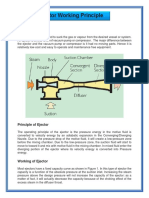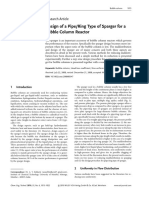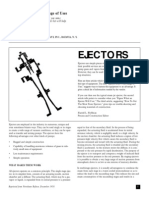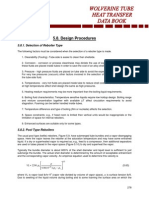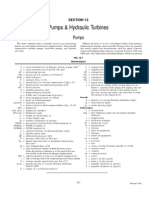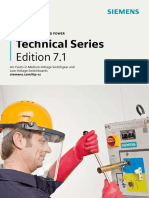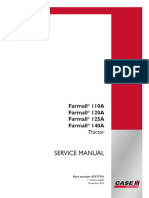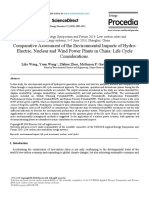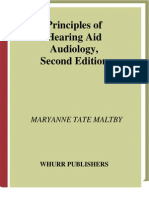Ejector Basics
Ejector Basics
Uploaded by
a234f56Copyright:
Available Formats
Ejector Basics
Ejector Basics
Uploaded by
a234f56Copyright
Available Formats
Share this document
Did you find this document useful?
Is this content inappropriate?
Copyright:
Available Formats
Ejector Basics
Ejector Basics
Uploaded by
a234f56Copyright:
Available Formats
Steam Ejectors:
Steam ejectors comprise of converging diverging nozzle through which high-pressure steam (motive fluid) is forced through. (Fig.1). The ejector nozzle converts the high-pressure head of the motive fluid into high velocity stream as it emerges from the nozzle into the suction chamber. Due to increase in velocity head, there is a drop in pressure head causing partial vacuum in the suction chamber. Pumping action occurs as the fluid / vapors present in suction chamber are entrained by the motive fluid and are carried into the diffuser, by viscous drag process.
Fig.1 The operating medium for ejectors (motive fluid) can be vapor, gas or liquid under pressure. Generally, high-pressure steam is used and in such cases they are known as steam ejectors. In the diffuser section of the nozzle, the velocity of the mixture is recovered to pressure head greater than suction pressure but much lower than the motive pressure. This pressure (diffuser pressure) must be equal or higher than the backing pressure for stable operation. In order to get low vacuum multiple stages are used which are broadly classified in the, table1
under.
The capacity of steam ejector is directly proportional to the weight of the motive fluid. Generally, the ratio of motive fluid to the gas pumped is high, especially under low vacuum and results in excessive demand of steam in multi-stage systems. The overall performance of steam ejector is sensitive to changes in operative parameters such as motive steam pressure and discharge pressure. A slight variation in operating parameters weighs heavily on the system capacity. Multi steam ejectors require inter-stage condensing as each stage adds to the pumping load for the succeeding stage and for reason of economy, condensation becomes important. The heat gained during condensation i.e. latent heat of vaporization, adds to the need for additional equipment such as re-circulation pumps, cooling towers etc. so that the same can be dissipated. In a steam ejector, steam comes in direct contact with gas/vapour pumped and many a time, this mixture of pumped vapour and water needs elaborate treatment before it can be discharged / re-used. Steam ejectors, especially multistage not only require steam generation facilities but also raise demand for auxiliary equipment such as D.M. plant for boiler feed water, condensing units, re-circulation pumps, cooling towers, effluent treatment plant etc. thereby increasing total energy consumption and maintenance costs. Steam ejectors are, therefore, no longer popular as they were once because of dramatic increase in cost of steam generation, auxiliary power and effluent treatment problems. It is for this reason many steam ejector installations have been replaced by mechanical Vacuum Pumps which use far little energy for the same service and require no additional auxiliary power, cooling tower nor give rise to effluent.
You might also like
- Steam Ejector CalculationsDocument9 pagesSteam Ejector CalculationsN. S. Pandit100% (6)
- Ejector Working PrincipleDocument11 pagesEjector Working Principleanuram66100% (3)
- Special Process Items - Excerpt From Mihir's HandbookDocument17 pagesSpecial Process Items - Excerpt From Mihir's HandbookPedrito CalapuchaNo ratings yet
- How To Calculate The Flowrate of Motive Fluid in An EjectorDocument3 pagesHow To Calculate The Flowrate of Motive Fluid in An EjectorRajesh Krishnamoorthy100% (3)
- Design of A PipeRing Type of Sparger For A Bubble Column Reactor PDFDocument8 pagesDesign of A PipeRing Type of Sparger For A Bubble Column Reactor PDFAshkanHosseini100% (1)
- Steam Jet Ejectors For The Process Industries PDFDocument521 pagesSteam Jet Ejectors For The Process Industries PDFBolívar Amores67% (6)
- Sizing Vacuum Pump or Ejector For Chemical ProcessDocument4 pagesSizing Vacuum Pump or Ejector For Chemical ProcessscranderiNo ratings yet
- Fire TechnologyDocument66 pagesFire TechnologyClarito LopezNo ratings yet
- STS365TDocument8 pagesSTS365TĐỗ DũngNo ratings yet
- Ejector FundamentalsDocument6 pagesEjector Fundamentalscordobaluisf100% (1)
- Process Steam Systems: A Practical Guide for Operators, Maintainers, and DesignersFrom EverandProcess Steam Systems: A Practical Guide for Operators, Maintainers, and DesignersNo ratings yet
- Vacuum, Steam Ejectors, Atmospheric Air Ejectors PDFDocument13 pagesVacuum, Steam Ejectors, Atmospheric Air Ejectors PDFRichard ObinnaNo ratings yet
- Steam Jet EjectorDocument6 pagesSteam Jet Ejectorjayanta_198967% (3)
- EjectorsDocument5 pagesEjectorsJaykumarNo ratings yet
- Steam Ejector DesignDocument4 pagesSteam Ejector DesignHaider Tyebally TyeballyNo ratings yet
- 6DSUPP Desuperheater Supplement BrochureDocument4 pages6DSUPP Desuperheater Supplement BrochureПавел ЛукьяновNo ratings yet
- Evaluation of Steam Jet EjectorsDocument11 pagesEvaluation of Steam Jet EjectorsRajeh Somrani100% (3)
- Case Study-Steam Jet EjectorDocument21 pagesCase Study-Steam Jet Ejectorgateauxboy67% (6)
- Vacuum EjectorDocument6 pagesVacuum EjectorAmol KadamNo ratings yet
- Design 2 ReboilerDocument5 pagesDesign 2 ReboilerAbdulrazzaqAL-MalikyNo ratings yet
- Evaluate Filtration Feasibility in ANFDDocument3 pagesEvaluate Filtration Feasibility in ANFDpratikNo ratings yet
- Steam Jet Ejectors: Index DescriptionDocument18 pagesSteam Jet Ejectors: Index DescriptionMuhammad NaveedNo ratings yet
- Thermocompressor PerformanceDocument8 pagesThermocompressor PerformanceLaboratorio PapelesRegionalesNo ratings yet
- EjectorDocument45 pagesEjectorDeep Das100% (3)
- Effect of Fouling FactorDocument5 pagesEffect of Fouling FactorMehta Mehul100% (1)
- Reboilers PDFDocument0 pagesReboilers PDFtpchoNo ratings yet
- Vacuum Pump Sizing PDFDocument1 pageVacuum Pump Sizing PDFLiem Nguyen100% (1)
- Barometric Leg DefinedDocument1 pageBarometric Leg DefinedHassan AssegafNo ratings yet
- 6.0 Steam/Condensate Lines Preface: Chart D 3.1Document18 pages6.0 Steam/Condensate Lines Preface: Chart D 3.1Cristhian100% (1)
- Calculation For Vacuum CondenserDocument0 pagesCalculation For Vacuum Condenserraden_aditiya39No ratings yet
- Vapor Liquid Separator PDFDocument10 pagesVapor Liquid Separator PDFClemenNo ratings yet
- Saturated Steam Vs Supereated SteamDocument3 pagesSaturated Steam Vs Supereated SteamPravin KumarNo ratings yet
- Unit Operations Thumb RulesDocument9 pagesUnit Operations Thumb RuleshibhavuNo ratings yet
- Design & Performance Evaluation of Steam EjectorDocument6 pagesDesign & Performance Evaluation of Steam EjectorAnonymous UY9QffNo ratings yet
- (Distillation) - Towers Malfunctions (Kister)Document22 pages(Distillation) - Towers Malfunctions (Kister)Ana Lua100% (1)
- Selection of Air Ejectors: Part I. Basic Design, Operating Information, and Operation Limitations of Air EjectorsDocument9 pagesSelection of Air Ejectors: Part I. Basic Design, Operating Information, and Operation Limitations of Air Ejectorsmyungkwan haNo ratings yet
- ReactiveDistillation ReviewDocument17 pagesReactiveDistillation ReviewSirajuddinNo ratings yet
- Line Sizing Tool Hydrogen Line 800 m3Document31 pagesLine Sizing Tool Hydrogen Line 800 m3Ahmed HassanNo ratings yet
- We Are Intechopen, The World'S Leading Publisher of Open Access Books Built by Scientists, For ScientistsDocument18 pagesWe Are Intechopen, The World'S Leading Publisher of Open Access Books Built by Scientists, For ScientistsManojNo ratings yet
- Thermosiphon OperationDocument63 pagesThermosiphon OperationRajesh100% (2)
- Designing Steam Jet EjectorDocument6 pagesDesigning Steam Jet EjectorAmin SmileyNo ratings yet
- Line SizingDocument13 pagesLine Sizingadil alameenNo ratings yet
- Steam Ejector HysysDocument4 pagesSteam Ejector Hysysfluto100% (1)
- Centrifugal Compressor Construction and TestingDocument10 pagesCentrifugal Compressor Construction and Testingmusaveer50% (2)
- GPSA m12 PumpDocument20 pagesGPSA m12 PumpGift Piyapong88% (8)
- Kettle Reboilers Chemical Engineering Design Ray SinnoyDocument6 pagesKettle Reboilers Chemical Engineering Design Ray SinnoyFederico BogettiNo ratings yet
- Kettle ReboilersDocument6 pagesKettle ReboilersHow Jie WeiNo ratings yet
- Sizing Heating and Cooling CoilsDocument4 pagesSizing Heating and Cooling Coilsbehnamhf2No ratings yet
- Falling Film EvaporatorDocument39 pagesFalling Film Evaporatormailnehru8955No ratings yet
- Design of EjectorDocument7 pagesDesign of EjectorRavi RanjanNo ratings yet
- CondenserDocument23 pagesCondenserAndiNo ratings yet
- Distillation Design and Control Using Aspen SimulationFrom EverandDistillation Design and Control Using Aspen SimulationRating: 5 out of 5 stars5/5 (2)
- Chemical Reactor Analysis and Applications for the Practicing EngineerFrom EverandChemical Reactor Analysis and Applications for the Practicing EngineerNo ratings yet
- How Does An Air Ejector Work?Document2 pagesHow Does An Air Ejector Work?rajishrrrNo ratings yet
- Gas CompressorDocument10 pagesGas Compressoramir100% (3)
- Nozzles Notes PDFDocument83 pagesNozzles Notes PDFAbubakkar Siddiq83% (6)
- SteamDocument24 pagesSteamsanju_17100% (2)
- Poly (Vinyl Chloride) (PVC) Plastic Pipe, Schedules 40, 80, and 120Document11 pagesPoly (Vinyl Chloride) (PVC) Plastic Pipe, Schedules 40, 80, and 120Flor PeraltaNo ratings yet
- Camsco E Catalog PDFDocument384 pagesCamsco E Catalog PDFKelvyn Raqui100% (1)
- EMY70CLP 220-240 V 50 HZ 1Document3 pagesEMY70CLP 220-240 V 50 HZ 1elielNo ratings yet
- Convair Prestige 900P Parts List 2009 Wallpaper Removal Sydney Call 0423688352Document2 pagesConvair Prestige 900P Parts List 2009 Wallpaper Removal Sydney Call 0423688352José Roberto Simões100% (1)
- 07 Arcing Faults in Medium and Low Voltage SwitchgearDocument20 pages07 Arcing Faults in Medium and Low Voltage SwitchgearGeorge TawfikNo ratings yet
- g8 T2L1 Electric ForceDocument32 pagesg8 T2L1 Electric Forcemobea2010No ratings yet
- CASE IH Farmall 120A Tractor Service Repair ManualDocument31 pagesCASE IH Farmall 120A Tractor Service Repair Manualejky93201573No ratings yet
- Experiment 2Document17 pagesExperiment 2Simyeen LeongNo ratings yet
- Product Catalogue August 2018Document73 pagesProduct Catalogue August 2018Wylbert ConsueloNo ratings yet
- The Situation of Waste Disposal in Barangay BalimbingDocument13 pagesThe Situation of Waste Disposal in Barangay BalimbingKayPaulineLotoDelacruzNo ratings yet
- Earthing (AEMC 3640,4610) PDFDocument44 pagesEarthing (AEMC 3640,4610) PDFZin BoNo ratings yet
- Twin-Screw Extruder and Effective Parameters On The HDPE Extrusion ProcessDocument4 pagesTwin-Screw Extruder and Effective Parameters On The HDPE Extrusion ProcessnguyenhuanNo ratings yet
- The Allen Engine-Charles T. PorterDocument3 pagesThe Allen Engine-Charles T. PorterLuis VizcaínoNo ratings yet
- Repairing & Testing YSUS & Buffers For Samsung 50" Plasma PS50Q96HD PS50Q97HDDocument5 pagesRepairing & Testing YSUS & Buffers For Samsung 50" Plasma PS50Q96HD PS50Q97HDEhduard Vehov75% (4)
- Frenic 5000M3 Instruction ManualDocument16 pagesFrenic 5000M3 Instruction Manualcoronaqc100% (1)
- Mohamed Project Machine Qjt4-40Document18 pagesMohamed Project Machine Qjt4-40mohamedNo ratings yet
- 007d Schneider Electric Reclosers Loop Automation Classic Intelligent 1 - 1Document31 pages007d Schneider Electric Reclosers Loop Automation Classic Intelligent 1 - 1César Bolaños QuirósNo ratings yet
- Sciencedirect: 2 X X 2 X XDocument6 pagesSciencedirect: 2 X X 2 X Xjesus.herediaNo ratings yet
- LR Trittico Startronic Premium 2022 EngDocument4 pagesLR Trittico Startronic Premium 2022 Engnunesoliveira.fabioNo ratings yet
- Nautiflow Nf1 Electromagnetic Flowmeter: Technical DatasheetDocument12 pagesNautiflow Nf1 Electromagnetic Flowmeter: Technical Datasheetadi michaelNo ratings yet
- CoV - Bulletin Green Buildings Policy For RezoningDocument4 pagesCoV - Bulletin Green Buildings Policy For RezoningAakash GoliyanNo ratings yet
- Esas Preboard Objectives PDFDocument40 pagesEsas Preboard Objectives PDFJarvisNo ratings yet
- PUNJAB ADP 2014-15: Planning & Development BoardDocument65 pagesPUNJAB ADP 2014-15: Planning & Development BoardumershNo ratings yet
- msebDocument2 pagesmsebbasitNo ratings yet
- GWP Protective Lithium Ion Shipping GuideDocument13 pagesGWP Protective Lithium Ion Shipping GuideJason FitchNo ratings yet
- Principles of Hearing Aid AudiologyDocument350 pagesPrinciples of Hearing Aid Audiologybalajiaslp100% (1)
- Commercial Volume Water Heater Brute Series BNTV Iomanual Pag.24 y 25Document104 pagesCommercial Volume Water Heater Brute Series BNTV Iomanual Pag.24 y 25Edinson Herrera VasquezNo ratings yet
- Water Cooled ChillerDocument5 pagesWater Cooled ChillerMUHAMMAD TAHA100% (2)

